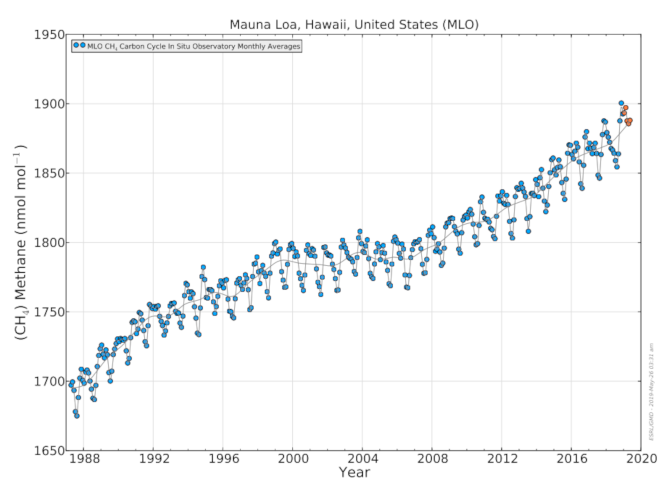There are three distinct possibilities:
- There is evidence that climate change has altered the concentration or level of pollution in air
- The evidence of the effect climate change has on the concentration or level of pollution in air is lacking
- Climate change has no influence on pollution in air period
The American Lung Association seems to support the position that not only is climate change real but air pollution in America has been made worse on account of it.
“The 21st annual ‘State of the Air’ report finds that climate change continues to make air pollution worse, with many western communities again experiencing record-breaking spikes in particle pollution due to wildfires,” the association notes1.
Though the intensities and numbers of wildland fires domestically may be on the rise, what proof is there that climate change is at the root of that changed dynamic?
“When it comes to air quality, changing climate patterns fuel wildfires and their dangerous smoke, and lead to worsened particle and ozone pollution,” the lung association added.
Though the above statement may be contextually true, does that offer as definitive, unequivocal proof that air pollution has been made worse on account of climate change directly?
Worth noting, meanwhile, is that six, count them, six air pollutant emissions, 1970 through 2018, have been in steady retreat2.
Rising CH4, CO2

Methane, a potent GHG, happens to also be a pollutant emission. Global warming in recent times, many believe, is a direct consequence of the recent uptick in atmospheric concentration of CO2, CH4 and other GHGs. Much of that increase, meanwhile, is owed to human activity in the form of fossil-fuel burning.
But, couldn’t it equally be as well that, due to the earth being hotter, at least some of the increase in the level of atmospheric CO2 and CH4 has come about on account of the release of CO2 and CH4 through melting-permafrost release?
What this would suggest is that it is not necessarily climate change but instead global warming behind what’s driving, in this case, the melted permafrost-based CO2 and CH4 emissions releases. Though climate change and global warming may be related constructs, they are not one and the same thing.
Carbon dioxide domes
There is such a thing as CO2 domes. And what are they?
These are just as the name implies: Effectively ginormous bubbles encapsulating cities mainly, under which sits high amounts of carbon dioxide gas. Pollutants get trapped underneath and this could have a devastating health effect.
In a 2010 study3 what was showed was that ratios of mixing of atmospheric CO2 are typically less elevated over rural areas than what they are over municipalities4. Also found was that said domes can affect both ozone and particle pollution due to feedbacks to such meteorological conditions as aerosolized H2O, breezes, rain and more5.
With this knowledge the thinking is that regulating carbon dioxide in the atmosphere in a manner not unlike to that of other pollutant emissions such as ozone and particulate matter, for example, this could have a crossover effect in that a reduction in local CO2 emissions could mean such could go a long way in helping to facilitate the cleanup of other emissions6, say, city-produced criteria air pollutants, for example. As another potential benefit, in areas where polluted air is a contributing factor in morbidity and early death7, by controlling emissions of CO2, such action taken could translate into declines in said conditions.
Possible changing mitigation implications
And, here’s something else to think about.

In the upcoming sequel further explored will be those ideas and more.
Notes
- “Nearly Half of U.S. Breathing Unhealthy Air; Record-breaking Air Pollution in Nine Western Cities,” Apr. 21, 2020 American Lung Association press release
- American Lung Association, State of the Air 2020 report, Fig. 1, p. 6 http://www.stateoftheair.org/assets/SOTA-2020.pdf
- Mark Z. Jacobson, “Enhancement of Local Air Pollution and Urban CO2 Domes,” Environmental Science Technology, 2010, Vol. 44, pp. 2497-2502 https://web.stanford.edu/group/efmh/jacobson/Articles/V/es903018m.pdf
- Ibid, p. 2497
- Ibid, p. 2501
- Ibid
- Ibid
Images: NOAA (upper); Laboratory for Aviation and the Environment at the Massachusetts Institute of Technology (lower)
This post was last revised on Aug. 12, 2020 @ 10:08 a.m. Pacific Daylight Time.
Published by Alan Kandel

3. Climate change has no influence on pollution in air period.
Well that’s pure crap.
Wildfires caused by Global Warming does release smoke, particulates of 2.5 or greater.
Maybe you don’t know this yet but we litter everywhere including the forests and most of our litter is plastic. Those wildfires are burning our litter too.
But by all means, keep misinforming the public.
My intent was to establish a premise from a choice of three and build a case in support of one of the three possibilities – It can’t be all three and it certainly is not number 3. In other words, not all three apply – only one.
Today’s post: Messing with weather: Is that messed up – or what? Maybe, maybe not” might help better clarify matters.